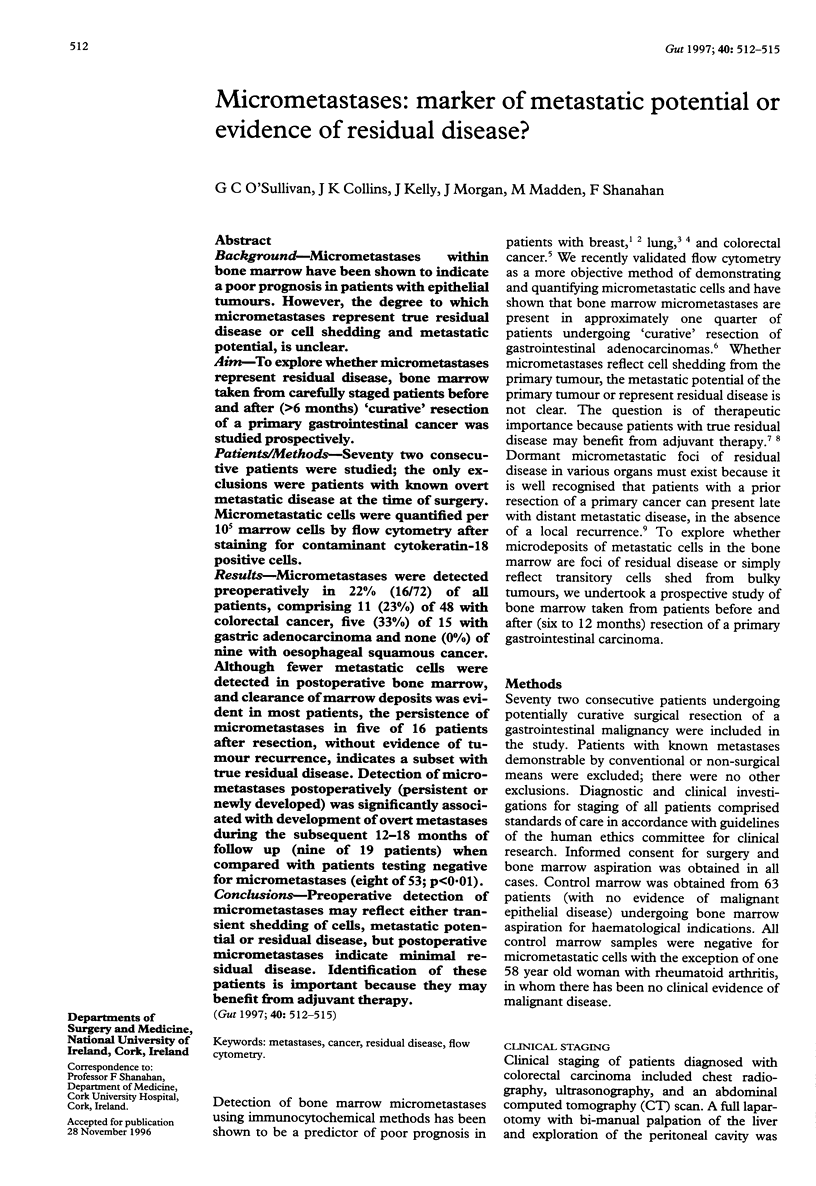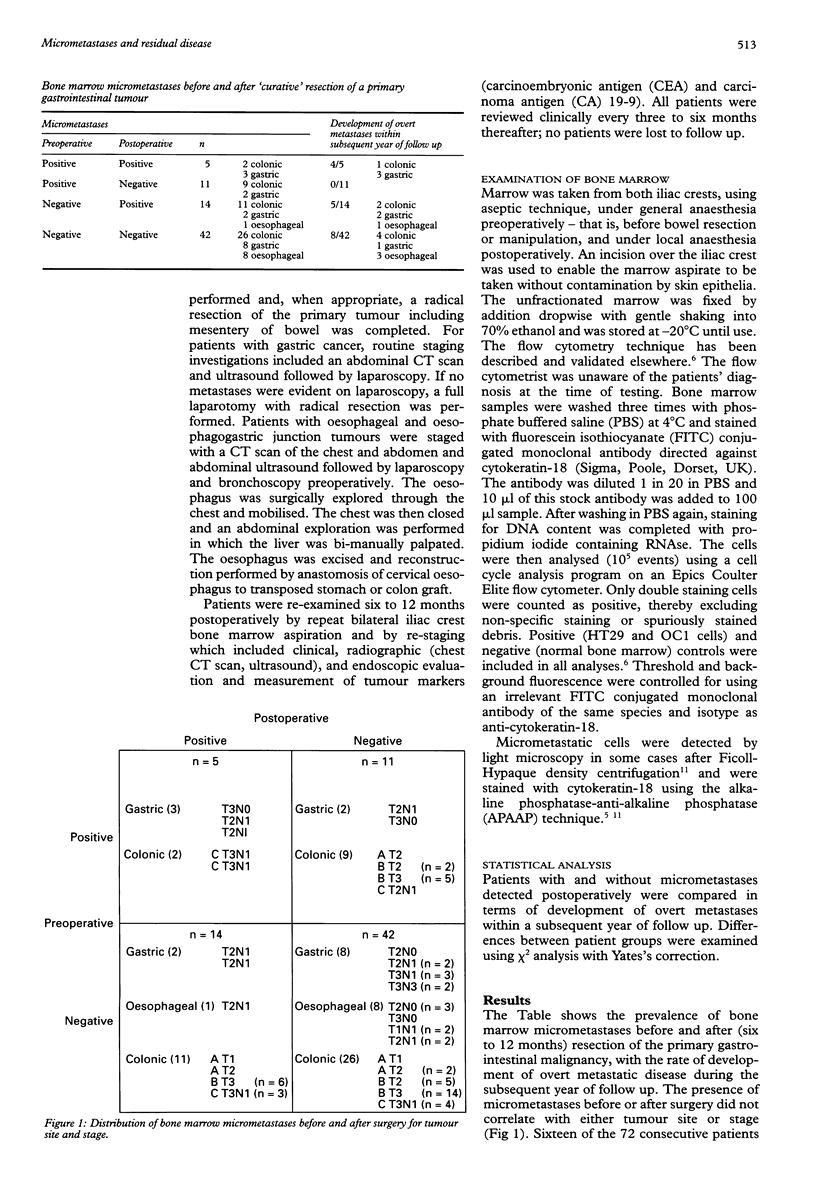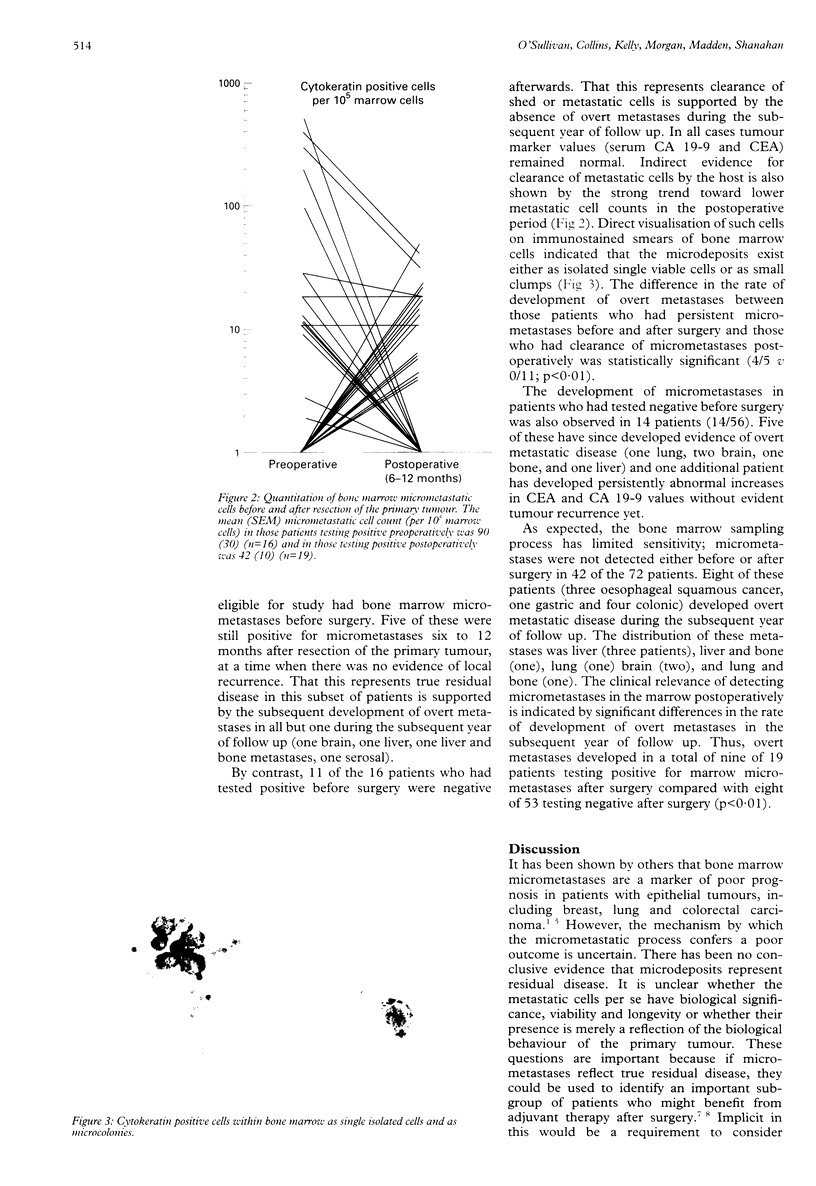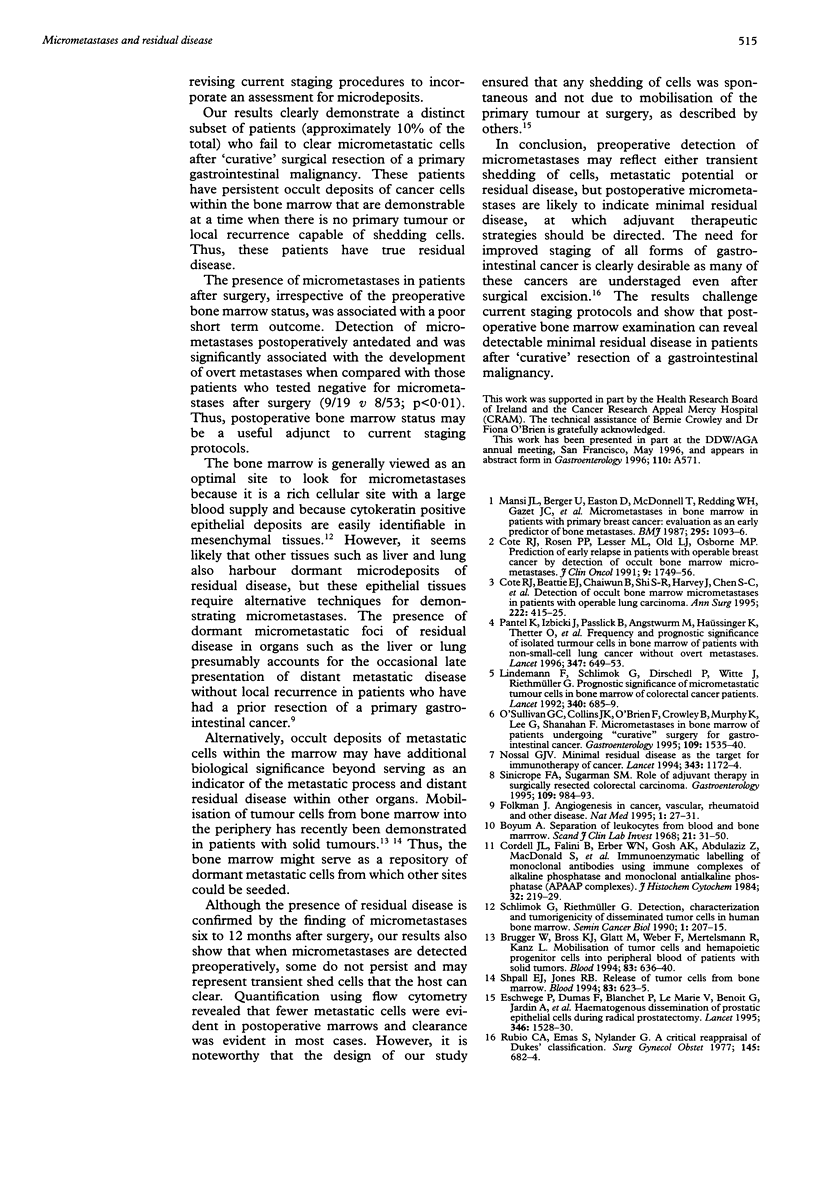Abstract
BACKGROUND: Micrometastases within bone marrow have been shown to indicate a poor prognosis in patients with epithelial tumours. However, the degree to which micrometastases represent true residual disease or cell shedding and metastatic potential, is unclear. AIM: To explore whether micrometastases represent residual disease, bone marrow taken from carefully staged patients before and after (> 6 months) "curative" resection of a primary gastrointestinal cancer was studied prospectively. PATIENTS/METHODS: Seventy two consecutive patients were studied; the only exclusions were patients with known overt metastatic disease at the time of surgery. Micrometastatic cells were quantified per 10(5) marrow cells by flow cytometry after staining for contaminant cytokeratin-18 positive cells. RESULTS: Micrometastases were detected preoperatively in 22% (16/72) of all patients, comprising 11 (23%) of 48 with colorectal cancer, five (33%) of 15 with gastric adenocarcinoma and none (0%) of nine with oesophageal squamous cancer. Although fewer metastatic cells were detected in postoperative bone marrow, and clearance of marrow deposits was evident in most patients, the persistence of micrometastases in five of 16 patients after resection, without evidence of tumour recurrence, indicates a subset with true residual disease. Detection of micrometastases postoperatively (persistent or newly developed) was significantly associated with development of overt metastases during the subsequent 12-18 months of follow up (nine of 19 patients) when compared with patients testing negative for micrometastases (eight of 53; p < 0.01). CONCLUSIONS: Preoperative detection of micrometastases may reflect either transient shedding of cells, metastatic potential or residual disease, but postoperative micrometastases indicate minimal residual disease. Identification of these patients is important because they may benefit from adjuvant therapy.
Full text
PDF



Images in this article
Selected References
These references are in PubMed. This may not be the complete list of references from this article.
- Brugger W., Bross K. J., Glatt M., Weber F., Mertelsmann R., Kanz L. Mobilization of tumor cells and hematopoietic progenitor cells into peripheral blood of patients with solid tumors. Blood. 1994 Feb 1;83(3):636–640. [PubMed] [Google Scholar]
- Cordell J. L., Falini B., Erber W. N., Ghosh A. K., Abdulaziz Z., MacDonald S., Pulford K. A., Stein H., Mason D. Y. Immunoenzymatic labeling of monoclonal antibodies using immune complexes of alkaline phosphatase and monoclonal anti-alkaline phosphatase (APAAP complexes). J Histochem Cytochem. 1984 Feb;32(2):219–229. doi: 10.1177/32.2.6198355. [DOI] [PubMed] [Google Scholar]
- Cote R. J., Beattie E. J., Chaiwun B., Shi S. R., Harvey J., Chen S. C., Sherrod A. E., Groshen S., Taylor C. R. Detection of occult bone marrow micrometastases in patients with operable lung carcinoma. Ann Surg. 1995 Oct;222(4):415–425. doi: 10.1097/00000658-199522240-00001. [DOI] [PMC free article] [PubMed] [Google Scholar]
- Cote R. J., Rosen P. P., Lesser M. L., Old L. J., Osborne M. P. Prediction of early relapse in patients with operable breast cancer by detection of occult bone marrow micrometastases. J Clin Oncol. 1991 Oct;9(10):1749–1756. doi: 10.1200/JCO.1991.9.10.1749. [DOI] [PubMed] [Google Scholar]
- Eschwège P., Dumas F., Blanchet P., Le Maire V., Benoit G., Jardin A., Lacour B., Loric S. Haematogenous dissemination of prostatic epithelial cells during radical prostatectomy. Lancet. 1995 Dec 9;346(8989):1528–1530. doi: 10.1016/s0140-6736(95)92054-4. [DOI] [PubMed] [Google Scholar]
- Folkman J. Angiogenesis in cancer, vascular, rheumatoid and other disease. Nat Med. 1995 Jan;1(1):27–31. doi: 10.1038/nm0195-27. [DOI] [PubMed] [Google Scholar]
- Lindemann F., Schlimok G., Dirschedl P., Witte J., Riethmüller G. Prognostic significance of micrometastatic tumour cells in bone marrow of colorectal cancer patients. Lancet. 1992 Sep 19;340(8821):685–689. doi: 10.1016/0140-6736(92)92230-d. [DOI] [PubMed] [Google Scholar]
- Mansi J. L., Berger U., Easton D., McDonnell T., Redding W. H., Gazet J. C., McKinna A., Powles T. J., Coombes R. C. Micrometastases in bone marrow in patients with primary breast cancer: evaluation as an early predictor of bone metastases. Br Med J (Clin Res Ed) 1987 Oct 31;295(6606):1093–1096. doi: 10.1136/bmj.295.6606.1093. [DOI] [PMC free article] [PubMed] [Google Scholar]
- Nossal G. J. Minimal residual disease as the target for immunotherapy of cancer. Lancet. 1994 May 14;343(8907):1172–1174. doi: 10.1016/s0140-6736(94)92394-9. [DOI] [PubMed] [Google Scholar]
- O'Sullivan G. C., Collins J. K., O'Brien F., Crowley B., Murphy K., Lee G., Shanahan F. Micrometastases in bone marrow of patients undergoing "curative" surgery for gastrointestinal cancer. Gastroenterology. 1995 Nov;109(5):1535–1540. doi: 10.1016/0016-5085(95)90641-x. [DOI] [PubMed] [Google Scholar]
- O'Sullivan G. C., Collins J. K., O'Brien F., Crowley B., Murphy K., Lee G., Shanahan F. Micrometastases in bone marrow of patients undergoing "curative" surgery for gastrointestinal cancer. Gastroenterology. 1995 Nov;109(5):1535–1540. doi: 10.1016/0016-5085(95)90641-x. [DOI] [PubMed] [Google Scholar]
- Pantel K., Izbicki J., Passlick B., Angstwurm M., Häussinger K., Thetter O., Riethmüller G. Frequency and prognostic significance of isolated tumour cells in bone marrow of patients with non-small-cell lung cancer without overt metastases. Lancet. 1996 Mar 9;347(9002):649–653. doi: 10.1016/s0140-6736(96)91203-9. [DOI] [PubMed] [Google Scholar]
- Rubio C. A., Emås S., Nylander G. A critical reappraisal of Dukes' classification. Surg Gynecol Obstet. 1977 Nov;145(5):682–684. [PubMed] [Google Scholar]
- Schlimok G., Riethmüller G. Detection, characterization and tumorigenicity of disseminated tumor cells in human bone marrow. Semin Cancer Biol. 1990 Jun;1(3):207–215. [PubMed] [Google Scholar]
- Shpall E. J., Jones R. B. Release of tumor cells from bone marrow. Blood. 1994 Feb 1;83(3):623–625. [PubMed] [Google Scholar]
- Sinicrope F. A., Sugarman S. M. Role of adjuvant therapy in surgically resected colorectal carcinoma. Gastroenterology. 1995 Sep;109(3):984–993. doi: 10.1016/0016-5085(95)90410-7. [DOI] [PubMed] [Google Scholar]



